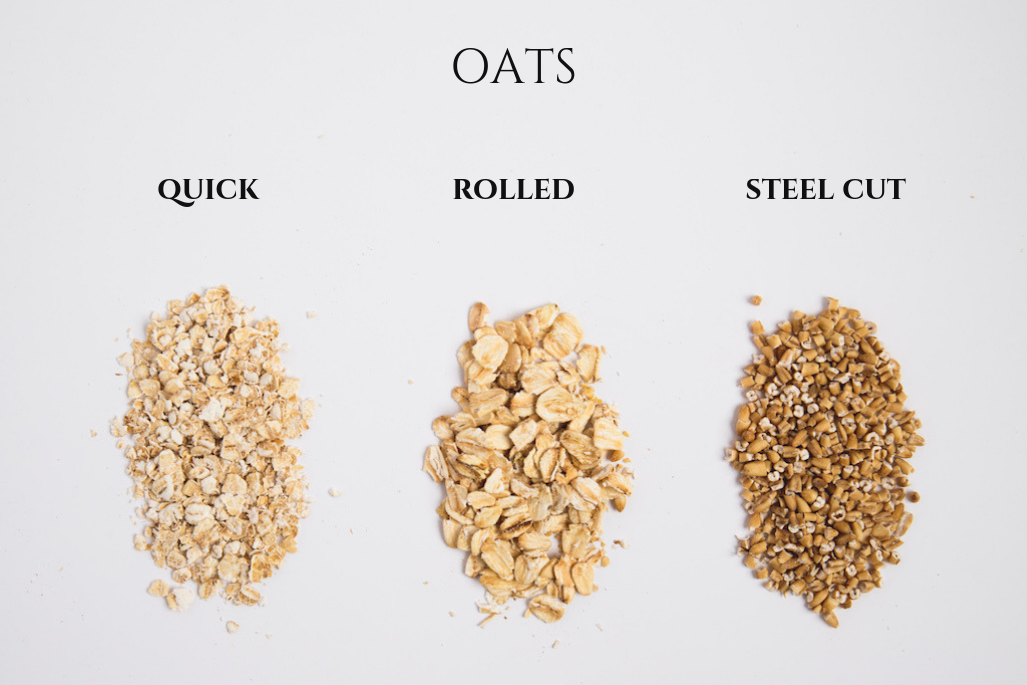Introduction
Oats are a versatile and nutritious whole grain that has gained popularity for their health benefits and culinary versatility. When browsing the oat aisle, you may come across various types, including rolled oats, steel-cut oats, and quick oats. Each type has its unique characteristics, taste, and texture, making them suitable for different culinary applications. In this comprehensive guide, we’ll explore the differences between rolled oats, steel-cut oats, and quick oats to help you choose the best option for your dietary preferences and cooking needs.
Understanding Oat Processing
Whole Grain Oats
Oats are a whole grain cereal grain that comes from the oat plant (Avena sativa). They are rich in nutrients such as fiber, protein, vitamins, and minerals, making them a nutritious addition to a balanced diet.
Processing Methods
Oats undergo different processing methods to create various types of oat products, including rolling, cutting, and steaming. The processing method used determines the final texture and cooking time of the oats.
Rolled Oats (Old-Fashioned Oats)
Processing Method
Rolled oats, also known as old-fashioned oats, are oat groats that have been steamed, rolled, and flattened into flakes. This process helps stabilize the oils in the oats, extending their shelf life and reducing cooking time.
Texture and Cooking Time
Rolled oats have a flat, flake-like texture and a softer, creamier consistency when cooked. They have a shorter cooking time compared to steel-cut oats, typically requiring 5-10 minutes to cook on the stovetop.
Usage
Rolled oats are versatile and can be used in various recipes, including oatmeal, granola, cookies, muffins, and pancakes. They absorb liquid well and are suitable for both stovetop cooking and baking.
Steel-Cut Oats
Processing Method
Steel-cut oats, also known as Irish oats or pinhead oats, are oat groats that have been cut into small pieces using steel blades. This minimal processing retains the oat’s natural texture and flavor.
Texture and Cooking Time
Steel-cut oats have a chewy texture and a nutty flavor. They take longer to cook than rolled oats due to their larger size and thicker texture, typically requiring 20-30 minutes to cook on the stovetop.
Usage
Steel-cut oats are ideal for recipes where texture is desired, such as hearty breakfast porridge, savory oatmeal bowls, and baked oat bars. They provide a satisfying chewiness and can be customized with various toppings and flavorings.
Quick Oats (Instant Oats)
Processing Method
Quick oats, also known as instant oats, are rolled oats that have been further processed into smaller, thinner flakes. This additional processing reduces the cooking time of the oats.
Texture and Cooking Time
Quick oats have a finer texture and softer consistency compared to rolled oats. They cook very quickly, typically requiring 1-3 minutes to cook on the stovetop or in the microwave.
Usage
Quick oats are convenient for individuals looking for a fast and easy breakfast option. They can be used to make quick oatmeal, overnight oats, smoothies, and baked goods. However, they may lack the texture and chewiness of steel-cut or rolled oats.
Nutritional Comparison
Nutrient Content
All varieties of oats are nutritious and provide essential nutrients such as fiber, protein, vitamins, and minerals. While the nutrient content remains relatively consistent across all types of oats, the glycemic index and cooking times may vary.
FAQs (Frequently Asked Questions)
Are Steel-Cut Oats Healthier Than Rolled Oats?
Steel-cut oats and rolled oats are both nutritious options that provide similar health benefits. The primary difference lies in their texture and cooking time, so choose based on personal preference and culinary needs.
Can I Substitute Rolled Oats for Steel-Cut Oats in Recipes?
Yes, you can substitute rolled oats for steel-cut oats in recipes, but keep in mind that the texture and cooking time may differ. Adjust cooking times and liquid ratios as needed to achieve the desired consistency.
Are Quick Oats Less Nutritious Than Rolled or Steel-Cut Oats?
Quick oats are processed to cook more quickly, but they retain similar nutritional content to rolled oats. While they may have a slightly higher glycemic index due to their smaller size, they still provide essential nutrients and can be part of a healthy diet.
Can I Use Steel-Cut Oats in Baking?
Yes, you can use steel-cut oats in baking, but keep in mind that they have a chewier texture compared to rolled oats. Consider soaking or partially cooking steel-cut oats before adding them to baked goods to soften their texture.
Are Oats Gluten-Free?
While oats themselves are naturally gluten-free, they may come into contact with gluten-containing grains during processing. To ensure gluten-free oats, look for products labeled as “certified gluten-free.”
Conclusion
Oats are a nutritious and versatile whole grain that comes in various forms, including rolled oats, steel-cut oats, and quick oats. Each type of oat offers its unique texture, flavor, and cooking time, making them suitable for different culinary applications. Whether you prefer the creaminess of rolled oats, the chewiness of steel-cut oats, or the convenience of quick oats, incorporating oats into your diet can provide numerous health benefits and endless culinary possibilities. Experiment with different types of oats to discover your favorite recipes and enjoy the wholesome goodness of this nutritious grain.
- What Reduces Lip Filler Swelling - May 23, 2025
- How To Achieve A Natural Look With Jaw Fillers In Kingston Upon Thames - May 22, 2025
- What Are The Best CBD Gummy Sweets For Sleep Improvement - May 21, 2025

